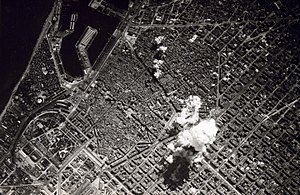69.211.50.168 (talk) No edit summary |
Nimetapoeg (talk | contribs) added Category:History of Barcelona using HotCat |
||
| Line 58: | Line 58: | ||
[[Category:War crimes of the Spanish Civil War]] |
[[Category:War crimes of the Spanish Civil War]] |
||
[[Category:Mass murder in 1938]] |
[[Category:Mass murder in 1938]] |
||
[[Category:History of Barcelona]] |
|||
Revision as of 19:49, 2 September 2013
| Bombing of Barcelona | |||||||
|---|---|---|---|---|---|---|---|
| Part of the Spanish Civil War | |||||||
 Bombing in Barcelona, 1938. | |||||||
| |||||||
| Belligerents | |||||||
|
|
| ||||||
| Commanders and leaders | |||||||
|
| |||||||
| Strength | |||||||
| Anti-aircraft artillery |
He-51 fighters Sa-79 and Sa-81 italian bombers | ||||||
| Casualties and losses | |||||||
| 1,000–1,300 civilians dead | None | ||||||
The Bombing of Barcelona was a series of Nationalist airstrikes which took place from 16 to 18 March 1938, during the Spanish Civil War. Up to 1,300 people were killed and at least 2,000 wounded.[1]
Background
On March 1938, the Nationalists started an offensive in Aragon, after the Battle of Teruel, and Germany occupied Austria. On 15 March, the French government, led by Leon Blum, decided to reopen the Spanish frontier[2] and the Russian supplies began to pass to Barcelona.[3] Then, Mussolini decided to carry out massive air bombings against Barcelona in order to "weakening the moral of the reds".[4] Mussolini thought, like the general Douhet, that aircraft could win a war with terror.[5]
The bombing
Between 16 and 18 March 1938, Barcelona was bombed by bombers of the Italian, Aviazione Legionaria.[6] This bombers flew from Mallorca with Spanish markings.[7] The first raid came at ten o'clock of 16 March by German Hidro-Heinkels. After that, there were 17 air raids by the Italian Sa-79 and Sa-81 bombers at three hours intervals until the three o'clock in the morning of 18 March.[8] Barcelona had little anti-aircraft artillery and no fighter cover.[9] The Spanish Republican Air Force (FARE) didn't send fighters to Barcelona until the morning of 17 March.[10]
The repeated wave of attacks carried out by the Italians would render irrelevant the air-raid alarm system since it would no longer be clear if the sirens were announcing the beginning or the end of an attack.[11] Furthermore, they used delayed-fuse bombs designed to pass through the roof and then explode inside the building and a new type of bomb which explode with a strong lateral force, so as to destroy things and persons within a few inches of the ground.[12] The bombings affected all the city and the bombers didn't attempt to destroy military targets.[13] On the night of 18 the working class districts were badly hit. The Italian bombers dropped 44 tons of bombs,[14] and there were more than 1,000 civilian dead (Beevor: 1,000 dead and 2,000 wounded;[15] Preston: around 1,000 dead;[16] and Thomas: 1,300 dead and 2,000 wounded).[17]
Aftermath
The Western democracies protested,[18] the American Secretary of State, Cordell Hull said: "No theory of war can justify such conduct. . . . I feel that I am speaking for the whole American people!".[19] And on 19 March, Franco asked for the suspension of the bombings, for fear of "complications abroad".[20] Mussolini was very pleased with the bombings. Ciano said that: "He was pleased by the fact that the Italians have managed to provoke horror, by their aggression instead of complacency with their mandolins. This will send up our stock in Germany, where they love total and ruthless war.".[21]
References
- Beevor, Antony. The battle for Spain. The Spanish civil war, 1936–1939. Penguin Books. 2006. London. ISBN 978-0-14-303765-1.
- Jackson, Gabriel. The Spanish Republic and the Civil War, 1931–1939. Princenton University Press. 1967. Princenton. ISBN 978-0-691-00757-1
- Preston, Paul. The Spanish Civil War. Reaction, revolution & revenge. Harper Perennial. 2006. London. ISBN 978-0-00-723207-9 ISBN 0-00-723207-1
- Thomas, Hugh. The Spanish Civil War. Penguin Books. 2001. London. ISBN 978-0-14-101161-5
Footnotes
- ^ Hugh Thomas (2001). The Spanish Civil War. Modern Library. p. 787. ISBN 0-375-75515-2.
- ^ Thomas, Hugh. The Spanish Civil War. Penguin Books. 2006. London. p.783
- ^ Jackson, Gabriel. The Spanish Republic and the Civil War, 1931–1939. Princeton University Press. Princeton. 1967. p.408
- ^ Beevor, Antony. The Battle for Spain. The Spanish Civil War, 1936–1939. Penguin Books. 2006. London. pp. 332–333
- ^ Thomas, Hugh. The Spanish Civil War. Penguin Books. 2006. London. p.785
- ^ Graham, Helen. The Spanish Civil War. A very short introduction. Oxford University Press. 2005. p.163
- ^ Preston, Paul. The Spanish Civil War. Reaction, revolution & revenge. Harper Perennial. London. 2006. p.283
- ^ Thomas, Hugh. The Spanish Civil War. Penguin Books. 2006. London. p.785
- ^ Beevor, Antony. The Battle for Spain. The Spanish Civil War, 1936–1939. Penguin Books. 2006. London. p.333
- ^ Beevor, Antony. The Battle for Spain. The Spanish Civil War, 1936–1939. Penguin Books. 2006. London. p.333
- ^ Preston, Paul. The Spanish Civil War. Reaction, revolution & revenge. Harper Perennial. London. 2006. p.283
- ^ Jackson, Gabriel. The Spanish Republic and the Civil War, 1931–1939. Princeton University Press. Princeton. 1967. p.408
- ^ Thomas, Hugh. The Spanish Civil War. Penguin Books. 2006. London. p.785
- ^ Massacre in Barcelona
- ^ Beevor, Antony. The Battle for Spain. The Spanish Civil War, 1936–1939. Penguin Books. 2006. London. p.333
- ^ Preston, Paul. The Spanish Civil War. Reaction, revolution & revenge. Harper Perennial. London. 2006. p.283
- ^ Thomas, Hugh. The Spanish Civil War. Penguin Books. 2006. London. p.785
- ^ Thomas, Hugh. The Spanish Civil War. Penguin Books. 2006. London. p.785
- ^ Foreign News: Barcelona Horrors Time Magazine, 28 March 1938
- ^ Thomas, Hugh. The Spanish Civil War. Penguin Books. 2006. London. p.785
- ^ Beevor, Antony. The Battle for Spain. The Spanish Civil War, 1936–1939. Penguin Books. 2006. London. p.333
External links